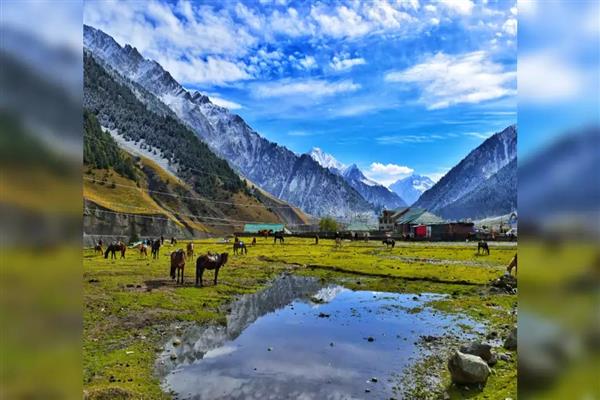Kashmir Magazine By : Kashmir Magazine | Srinagar, Publish Date: Tuesday, April 16, 2024 11:52:07 AM | Updated Date : Tuesday, April 16, 2024 11:52:07 AM

A decade ago, Kashmir's economy relied heavily on the horticulture industry, particularly the fruit market. However, a lack of attention to other sectors resulted in poor infrastructure. Today, there is significant growth in the tourism sector, especially in border tourism due to increased focus, peace initiatives, and infrastructure development. Kashmir is now considered the crown jewel of India, with every place being a tourist destination. Its increased accessibility, exploration, and exposure have boosted the tourism sector.
Growth in tourism in Kashmir is due to re-establishing peace in the valley. Previously, violence discouraged outsiders from visiting, damaging the industry. The last four years have seen a rise in global visitors, with new tourist destinations thriving and border tourism opening up due to enhanced security measures. Development in tourism contributes significantly to the region's economy.
Kashmir has transformed due to the government's efforts to develop border areas, improve road connectivity, and develop offbeat tourist destinations. This has made the region a hotspot for tourism, boosting the local economy. The efforts to provide accessibility and remove public restrictions have resulted in an increased influx of tourists in previously unimaginable locations. The government has extended telecommunications and electricity facilities to most locations, making them accessible to all citizens. With the recent opening of borders following the cessation of hostilities, tourists can enjoy the natural beauty in a peaceful atmosphere.
The government of India has taken measures to promote tourism in the border areas of Jammu and Kashmir, particularly in the districts of Bandipora, Kupwara, and Baramulla. Line of Control (LoC) has been open for tourists for the last two years, following the successful bilateral ceasefire agreement between India and Pakistan. This move has brought normalcy to the residents of the border areas and officials believe it has unlocked significant tourism potential. A tourism festival was organised in August 2021 at the Bangus Valley in the Kupwara district, highlighting the collaborative efforts of the UT's tourism department and the Army in facilitating visits to such remote destinations.
Since August 2019, following the abrogation of Article 370 and 35A, there has been rejuvenation in tourism in Kashmir. Border areas have seen a significant increase in local, national, and international tourists, transforming these once-dreaded locations into attractions. Notably, Keran, Lolab, Machil, Teetwal, Tangdhar, Gurez, Tulail, and Uri in north Kashmir have seen a swift rise in popularity and are now identified as premier border tourist destinations in the region. The influx of tourists has not only boosted the local economy but has also led to the improvement of visitor facilities. Each pass holds unique beauty, nature, and historical significance, enriching the tourist’s experience and showcasing the region’s diversity.
The year 2021, brought hope to the people of Jammu and Kashmir Union Territory as the Director Generals of Military Operations of India and Pakistan agreed to a ceasefire on the Line of Control (LoC). This agreement opened doors to peace, allowing nature enthusiasts to visit the heavenly border areas of Kashmir, particularly north Kashmir's Kupwara. The unexpected surge in visitors to areas such as Karna, Keran, Machil, Lolab, Bangus, and Dringyari was heartening, indicating as if people were eagerly awaiting the ceasefire agreement.
In 2023, tourist footfall in Keran, Karna, Machil, and Bangus exceeded expectations, and the people living in these border areas welcomed visitors with open arms. They provided hospitality with love, affection, and respect, making tourists feel at home. These villages (previously no-go zones) became the perfect spots for camping, bonfires, trekking, rafting, and fishing, bringing charming experiences for the visitors. The Indian army collaborated with the respective district administrations and tourism departments to promote border tourism in north Kashmir.
The Shinon Meeras establishment–a cultural centre–at Gurez Valley was a significant step towards showcasing the Dard-Shina tribes. The centre was curated through collaborative efforts between the Indian Army and the administration and is dedicated to the 38,000-strong Dard community, whose language is rapidly diminishing. The Indian Army also created a transient facility at Sadhna Pass. It alleviates the inconvenience and hardships of locals and tourists and simultaneously highlights the rich history, culture, and traditions of Karnah Valley. The unexpected surge in tourist footfall and the collaboration between the Indian Army and the administration in collaboration put every possible thing in action to promote tourism in border areas to establish peace and help their economy grow.
Indeed border tourism is a new brilliant chapter added to the socio-economic landscape of Kashmir. It will enforce peace and prosperity to strengthen their roots in the valley. The initiative to open borders for tourism was indeed the government's tremendous move.